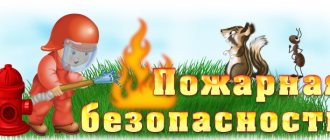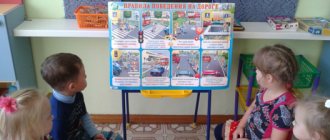Summary of OOD in the senior group on the topic “Safety in the forest and park”
Summary of OOD in the senior group on the topic “Safety in the forest and park”
Author: Chirova Polina Sergeevna, teacher of MBDOU No. 79 “BOY-KIBALCHISH”, Severodvinsk
This work is useful for educators. The summary is intended for children of the older group (5-6 years old). The notes can be used as a main lesson, as well as as a circle lesson.
Program content:
Target:
Formation of children's knowledge about the rules of safe behavior in nature (in the forest, park).
Tasks:
1. Formation of knowledge in children about sources of danger in the forest, park: insects, plants, fire, old trees.
2. Formation of knowledge in children about the rules of safe behavior in the forest.
3. Formation of knowledge in children about actions in dangerous situations in the forest.
4. Development of attention and logical thinking.
5. Foster a sense of caring for your health.
Methods and techniques:
conversation, looking at illustrations, reading poems, artistic expression, didactic games, reading fiction.
Progress of the lesson:
Educator:
Guys, today we will go for a walk in the forest. What is a forest? (many trees, mushrooms and berries grow, animals live in the forest).
- Why do people go to the forest? (rest, breathe fresh air, pick mushrooms, berries). What is a park? Why do we go to the park?
- Right! Why do we need fresh air? (so as not to get sick, to be healthy).
— A forest is the green wealth of nature, beauty, health, a place where you can relax and take a walk! So now we will go with you to the forest to relax and breathe fresh air. And for a walk in the forest, we need to take with us items that may be useful to us.
A d/i “What should we take with us on a hike” is held - items that may be useful in the forest are selected.
Educator:
It seems they took everything and forgot nothing.
(audio recording “Sounds of Nature” is played)
Educator:
So we came to the forest. Let's look at the illustrations on the board. What do they show? What dangers await us in the forest and in the park?
Do you know what grows in the forest? (mushrooms, berries, herbs).
- Now we’ll check how you know the plants of the forest. (Game “Edible-Inedible”.
Educator:
How many mushrooms and berries grow in the forest! Are we collecting them? (Yes)
— Can all mushrooms, berries, and herbs be picked? (no, there are edible and inedible, poisonous).
— Why can’t you collect inedible plants?
They cannot be collected, as they are hazardous to health and also serve as medicine for animals.
Listen to one short story. The girl Masha was picking berries when she suddenly saw an unusual, unfamiliar berry, ate it, and after a while her stomach hurt. What should a girl do? (children's answers).
Summary of the lesson “Safety in nature” preparatory group
Topic: “Safety in nature”
Objectives: Educational:
— To develop basic environmental knowledge in children, to teach children the rules of behavior in the forest. — To develop in children knowledge of safe behavior: rules for handling fire hazardous objects, skills in protecting personal health and caring for the health of others. — Teach some first aid techniques in case of injury;
Educational:
— Develop a cognitive interest in the natural world, an idea of what actions harm nature. — Develop speech in conversation, logical thinking, attention through didactic games, the ability to make simple conclusions, inferences.
Educational:
— To instill in children environmental behavior, a responsible, humane, careful, emotionally positive attitude towards nature. — Instill labor natural history skills.
Equipment and material: Layouts: trees, fire, diary “The ABCs of safety in nature”
Signs: “Do not litter in the forest! ", "Do not leave an unextinguished fire in the forest", "Do not make noise in the forest! "
Items: backpack, items for d/i “What will we take with us on a hike”: box of matches, garbage bag, first aid kit, brilliant green, adhesive plaster, water bottle, cubes, iron.
“garbage”: juice boxes, candy wrappers, empty bags of chips, empty bottles of yoghurt and drinks.
Visual demonstration material:
Pictures depicting forest and vegetable garden plants; Safety signs.
Progress of the lesson
Introductory part: conversation
Educator: Guys, today we will go for a walk in the forest. What is a forest?
(many trees, mushrooms and berries grow, animals live in the forest).
- Why do people go to the forest?
(rest, breathe fresh air, pick mushrooms, berries).
- Right! Why do we need fresh air?
(so as not to get sick, to be healthy).
— A forest is the green wealth of nature, beauty, health, a place where you can relax and take a walk! So now we will go with you to the forest to relax and breathe fresh air. And for a walk in the forest, we need to take with us items that may be useful to us.
A d/i “What should we take with us on a hike” is held - items that may be useful in the forest are selected.
Educator: It seems they took everything and forgot nothing. We will also take this book with us. It is empty now, it has blank pages. We will put in it everything we learn about during our walk. (children line up one after another and go into the forest)
Main part:
(audio recording “Sounds of Nature” is played)
Educator: So we came to the forest. What is this? (there is a lot of garbage scattered in the clearing). The whole clearing is in the trash! Who did this? Is it possible to relax in such a clearing? What should we do, guys?




